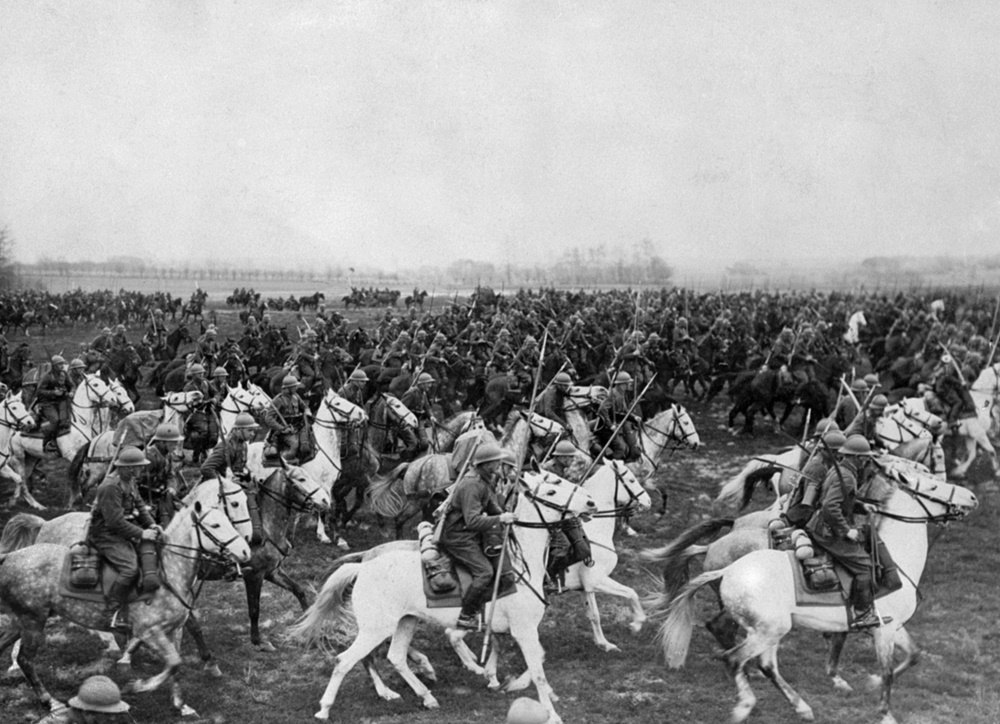Poland Resolute Against the German Might
The War Illustrated, Volume 1, No. 1, Page 20-21, September 16, 1939.
If you want a symbol of Poland in arms you will find it not in speeding aircraft, marching masses of infantry, rumbling tanks and mechanized artillery, but in a trooper of the national cavalry. Alert, swift-moving, ready for every eventuality, quick to seize every change in a changing situation – such is the man and the men on whom Poland depends in her hour of supreme crisis.
Poland’s horsemen have ever been famous for their das and gallantry, and their prowess is recorded in letters of gold in their country’s history. Today, as always in the past, Poland’s cavalry is the backbone of her army.
If it is thought strange that in this age of petrol, and machinery a nation should rely for the mobility of its armed forces on the horse. We should take a look at the map. Physically speaking, indeed, Poland has no well-marked boundaries save in the south-west, where a range of mountains separates her from Slovakia.
Elsewhere her boundaries are drawn across a vast plain largely roadless, and marked in many a place by lakes, woods, and great expanses of marshland. In the midst of such watery wastes mechanical fortresses, stiff with guns and heavy with armament, might well be worse than useless. Their speed would be cut down to a minimum, and the danger of bogging would confront them at every turn. How different, however, is the position of a cavalry force in such a region – a force which can take advantage of every little area of firm ground! Poland’s cavalry, equipped with sword, lance and machineguns, is said by some best qualified to know to be the best in Europe.
But Poland has not neglected her other arms. She has tanks of excellent quality and high performance, and her infantry recruited from a race of hard-working, long-enduring peasants – can march 30 to 40 miles a day, and have a courage equal to none. In the air the excellence of her positions is not so marked, but even so her air force has an estimated strength of 2,500 planes, and in particular, the Polish standard bomber can carry 2,5 tons at a top speed of over 300 miles per hour.
The Polish army actually numbers just over a quarter of a million men, but there are three million trained reserves. Furthermore, owing to the extraordinary youthfulness of the Polish population as a whole, the country could ultimately mobilize an army of six million men of military age.
Although Poland is presumed to possess nothing in the nature of a Maginot or Siegfried Line, practically all her big towns are armed camps or the centres of fortified systems.
Forts and armaments and huge resources in man power are no everything, however. There must in addition be that indefinable something that we very inadequately suggest when we use the word morale. Where that something resides is difficult to define, but at least it may be said to be personified in the country’s leaders – int hose men who have the control of the Republic. Poland is particularly fortunate in that her leader at the present hour of testing are all men who have been through the fires of adversity and know from actual experience what war means, how it should be carried on, and how victory may be won. Pilsudski, the father of the Republic, is dead, but his mantle has fallen upon his able lieutenant, Marshal Smigly Rydz, who today, as Inspector-General of the forces, is in effect the supreme controller of Poland’s destinies in peace and war. Surrounding him are many men of great ability and courage.
Surveying, then, the armed forces with which Poland is meeting the furious menace from beyond her borders, remembering her past history of vicissitudes crowned by ultimate triumph, and realizing the inspiration afforded by tried and trusted leaders, we may well believe that she may face the brutal challenge to her existence with the confidence born of material strength and spiritual resolve.
 The Poles are great horsemen and Poland is a great horse-breading country. Early in the war the Polish cavalry achieved conspicuous success against the invaders of their country. Though cavalry is still an important part of the Polish Army, it is retained only because of special conditions, and mechanization has been carried out in every branch where it is advantageous. Photos, Wide World, Associated Press and Planet News.
The Poles are great horsemen and Poland is a great horse-breading country. Early in the war the Polish cavalry achieved conspicuous success against the invaders of their country. Though cavalry is still an important part of the Polish Army, it is retained only because of special conditions, and mechanization has been carried out in every branch where it is advantageous. Photos, Wide World, Associated Press and Planet News.
Index
Previous article
Danzig and the Men Who Betrayed It
Situated at the mouth of the Vistula, great river of Eastern Europe, stands Danzig, the city which was the final objective in Hitler’s campaign of aggression. For centuries it has been a centre of e
Next article
Odd Facts About The War
Grey Hairs for the Firing Line "I watched columns of older reservists march to the trains that were to carry them to points near the Polish border. There was no flag waving, no military bands. The me



